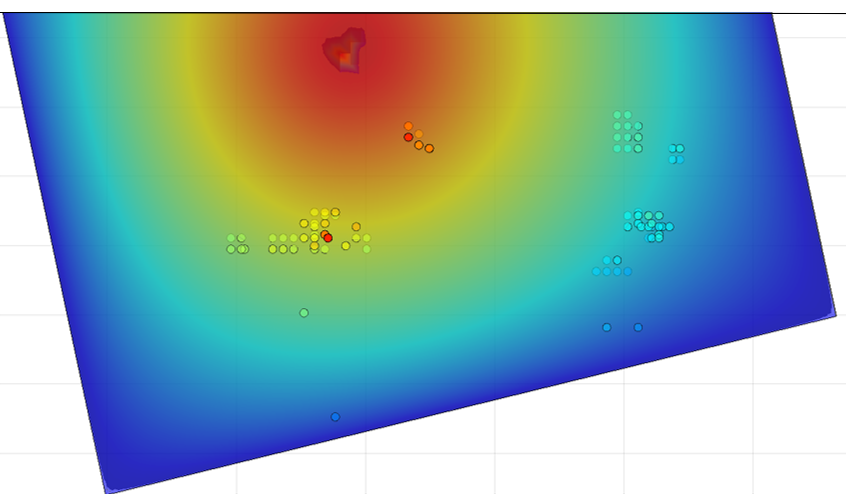Molecular Thermometer Works Near Absolute Zero
To study tiny systems such as microelectronic components, researchers would like to map cryogenic temperatures of structures at the nanoscale. But current techniques involve some heating that can spoil the measurements. Now a research team has demonstrated a cryogenic thermometer that provides microscale resolution and that has little effect on the temperature of the system being measured [1]. Single molecules embedded in tiny crystals are the sensors, and they have millikelvin sensitivity. The team says that the technique could be useful for a wide range of cryogenic studies of the thermal properties of surfaces having nanoscale structures.
Understanding and controlling heat flow through materials is essential for developing a wide range of technologies. For example, researchers have begun to use two-dimensional materials, such as graphene, cooled to cryogenic temperatures, to conduct heat away from hot spots in microelectronic devices. In these materials and at these low temperatures, heat can travel long distances without dissipation, which makes these materials extremely effective heat conductors. However, the precise mechanisms for this heat transport are still poorly understood. More generally, researchers would also like to better understand other anomalous thermal properties of materials that apply at these temperatures, such as a regime where heat flows as waves.
Victoria Esteso of the Italian National Institute of Optics (INO) and her colleagues want to make temperature maps of surfaces to better understand these properties, but current thermometry methods are limited. Techniques that can provide micrometer-scale resolution at cold temperatures aren’t appropriate for these experiments because of the amount of energy they transfer to the system being measured. This transfer is acceptable for some kinds of measurements but not for temperature mapping. So Esteso and her colleagues developed a new approach.
The researchers’ thermometers are nanocrystals, each of which contains a few molecules of dibenzoterrylene (DBT) encased in a matrix of anthracene. Both DBT and anthracene are organic compounds. When illuminated with a red laser, the DBT molecules fluoresce—emit light centered at a specific wavelength—with a spectral linewidth that broadens as the temperature rises. Thus, measuring this width gives the nanocrystal’s temperature.
Esteso and her colleagues tested the technique by measuring the temperature of a particularly challenging system—a silicon membrane containing a triangular lattice of 400-nm-wide holes, which occupy 60% of the membrane’s area. This type of “nanostructured” membrane is thought to be potentially useful for managing the flow of heat in certain microelectronic devices. First the researchers mixed DBT and anthracene in water and grew nanocrystals from the solution; then they placed a thin layer of the nanocrystal-containing liquid on the membrane and allowed the water to evaporate. The team then used a laser beam to sequentially heat a series of spots on the membrane at various distances from a crystal and used another laser to illuminate the crystal and measure its temperature in each case. The resulting plot of temperature vs. distance matched a theoretical model, validating the thermometry technique.
In another demonstration, the researchers heated a spot on the membrane and illuminated crystals spread across the surface to create a micrometer-resolution temperature map of the membrane. This map allowed them to determine the membrane’s thermal conductivity.
The laser used to generate fluorescence in the DBT molecules is low power, in the nanowatt range, so its heating effect is negligible, says team leader Costanza Toninelli, also of INO. “We measure temperature without having an appreciable transfer of heat between the molecule and the membrane,” she says.
The thermometer works best at temperatures between 3 and 20 K. While the researchers aim to use the technique to study heat transfer in nanostructured membranes, they say that the method could also have commercial applications. A Germany-based nanotechnology company has already expressed interest in using this method to map the temperature within its temperature-regulating devices (cryostats), Toninelli says.
“Using single-molecule spectroscopy in this temperature range is quite unique,” says Carlos Brites, who studies photonics and nanomaterials at the University of Aveiro in Portugal. He says that in the relatively new field of nanothermometry, it’s helpful to have new techniques that target new applications.
–Sophia Chen
Sophia Chen is a freelance science writer based in Columbus, Ohio.
References
- V. Esteso et al., “Quantum thermometry with single molecules in nanoprobes,” PRX Quantum 4, 040314 (2023).







